Air flow control damper with linear performance characteristics comprising an air foil control blade and inner annular orifice
a technology of air foil control and linear performance characteristics, which is applied in the direction of lighting and heating apparatus, ventilation systems, heating types, etc., can solve the problems of unstable performance characteristics, low flow, and low performan
- Summary
- Abstract
- Description
- Claims
- Application Information
AI Technical Summary
Problems solved by technology
Method used
Image
Examples
Embodiment Construction
[0021]FIG. 1 shows a side view of an ordinary control damper composed of an outer casing (1) with a flat air control blade (2) and without a internal orifice. Also shown is the flat blade a primarily open position. Again the airflow patterns (3) are shown deflected by the blade most of which pass through the damper parallel to the axis of the damper and the remainder will impact the inner surface of the outer casing shown. In this instance there is a minimal amount of the air flow impacting the inner surface of the outer casing (1).
[0022]FIG. 2 shows that same ordinary control damper with an outer casing (1) with the flat control blade (2) at a mid point position approximately 45 deg to the axis of the casing. Also shown are air flow patterns (3) deflected by the blade (2) most of which pass through the damper at about a 45 deg angle to the axis of the damper and the remainder will impact the inner surface of the outer casing (1) with some force and loss of energy prior to passing t...
PUM
 Login to View More
Login to View More Abstract
Description
Claims
Application Information
 Login to View More
Login to View More - R&D
- Intellectual Property
- Life Sciences
- Materials
- Tech Scout
- Unparalleled Data Quality
- Higher Quality Content
- 60% Fewer Hallucinations
Browse by: Latest US Patents, China's latest patents, Technical Efficacy Thesaurus, Application Domain, Technology Topic, Popular Technical Reports.
© 2025 PatSnap. All rights reserved.Legal|Privacy policy|Modern Slavery Act Transparency Statement|Sitemap|About US| Contact US: help@patsnap.com



